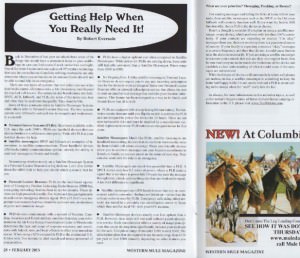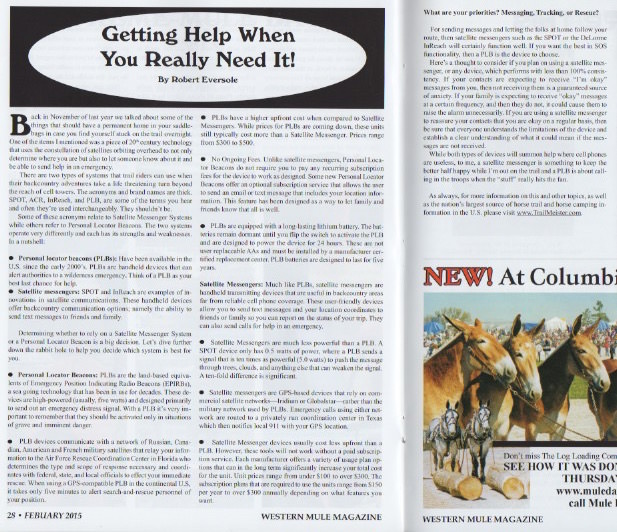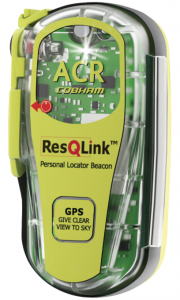 Getting help when you really need it. – PLB vs. SMS
Getting help when you really need it. – PLB vs. SMS
As published in Western Mule Magazine – Feb 2015
Back in November of last year we talked about some of the things that should have a permanent home in your saddlebags in case you find yourself stuck on the trail overnight. One of the items I mentioned was a piece of 21st century technology that uses the constellation of satellites orbiting overhead to not only determine where you are but also to let someone know about it and be able to send help in an emergency.
There are two types of systems that trail riders can use when their backcountry adventures take a life threatening turn beyond the reach of cell towers. The acronyms and brand names are thick. SPOT, ACR, InReach, and PLB, are some of the terms you hear and often they’re used interchangeably. They shouldn’t be.
Some of these acronyms relate to Satellite Messenger Systems while others refer to Personal Locator Beacons. The two systems operate very differently and each has its strengths and weaknesses.
In a nutshell:
- Personal locator beacons (PLBs): Have been available in the U.S. since the early 2000’s. PLB’s are handheld devices that can alert authorities to a wilderness emergency. Think of a PLB as your best last chance for help.
- Satellite messengers: SPOT and InReach are examples of innovations in satellite communications. These handheld devices offer backcountry communication options; namely the ability to send text messages to friends and family and can also function as an emergency beacon.
Determining whether to rely on a Satellite Messenger System or a Personal Locator Beacon is a big decision. Let’s dive further down the rabbit hole to help you decide which system is best for you.
PLB’s are the land-based equivalents of Emergency Position Indicating Radio Beacons (EPIRBs), a sea going technology that has been in use for decades. These devices are high-powered (usually, 5 watts) and designed primarily to send out an emergency distress signal. With a PLB it’s very important to remember that they should be activated only in situations of grave and imminent danger.
- PLB devices communicate with a network of Russian, Canadian, American and French military satellites that relay your information to the Air Force Rescue Coordination Center in Florida who determine the type and scope of response necessary and coordinates with federal, state, and local officials to effect your immediate rescue. When using a GPS-compatible PLB in the continental U.S, it takes only 5 minutes to alert search-and-rescue personnel of your position.
- PLB’s have a higher upfront cost when compared to Satellite Messengers. While prices for PLB’s are coming down, these units still typically cost more than a Satellite Messenger. Prices range from $300 to $500.
- No Ongoing Fees. Unlike satellite messengers, Personal Locator Beacons do not require you to pay any recurring subscription fees for the device to work as designed. Some new Personal Locator Beacons offer an optional, subscription service, that allows the user to send an email or text message that includes your location information. This feature has been designed as a way to let family and friends know that all is well.
- PLB’s are equipped with a long-lasting lithium battery. The batteries remain dormant until you flip the switch to activate the PLB and are designed to power the device for 24 hours. These are not user replaceable AA’s and must be installed by a manufacturer certified replacement center. PLB batteries are designed to last for 5 years.
Much like PLBs, satellite messengers are handheld transmitting devices that are useful in backcountry areas far from reliable cell phone coverage. These user-friendly devices allow you to send text messages and your location coordinates to friends or family so you can report on the status of your trip. They can also send calls for help in an emergency.
- Satellite Messengers are much less powerful than a PLB. A SPOT device only has 0.5 watts of power, where a PLB sends a signal that is ten times as powerful (5.0 watts) to push the message through trees, clouds, and anything else that can weaken the signal. A ten-fold difference is significant.
- Satellite messengers are GPS-based devices that rely on commercial satellite networks—Iridium or Globalstar—rather than the military network used by PLBs. Emergency calls using either network are routed to a privately run coordination center in Texas which then notifies local 911 with your GPS location.
- Satellite Messenger devices usually cost less upfront than a PLB. However, these tools will not work without a paid subscription service. Each manufacturer offers a variety of usage plan options that can in the long term significantly increase your total cost for the unit. Unit prices range from under $100 to over $300. The subscriptions plans that are required to use the units range from $150 per year to over $300 annually depending on what features you want.
 What are your priorities? Messaging, Tracking, or Rescue?
What are your priorities? Messaging, Tracking, or Rescue?
For sending messages and letting the folks at home follow your route, then satellite messengers such as the SPOT or the DeLorme InReach will certainly function well. If you want the best in SOS functionality, then a PLB is the device to choose.
Here’s a thought to consider if you plan on using a satellite messenger, or any device, which performs with less than 100% consistency. If your contacts are expecting to receive “I’m okay” messages from you, then not receiving them is a guaranteed source of anxiety. If your family is expecting to receive “okay” messages at a certain frequency, and then they do not, it could cause them to raise the alarm unnecessarily. If you are using a satellite messenger to reassure your contacts that you are okay on a regular basis, then be sure that everyone understands the limitations of the device and establish a clear understanding of what it could mean if the messages are not received.
While both types of devices will summon help where cell phones are useless. To me, a satellite messenger is something to keep the better half happy while I’m out on the trail and a PLB is about calling in the troops when the “stuff” really hits the fan.
As always, for more information on this and other topics, as well as the nation’s largest source of horse trail and horse camping information in the U.S. please visit www.TrailMeister.com.




